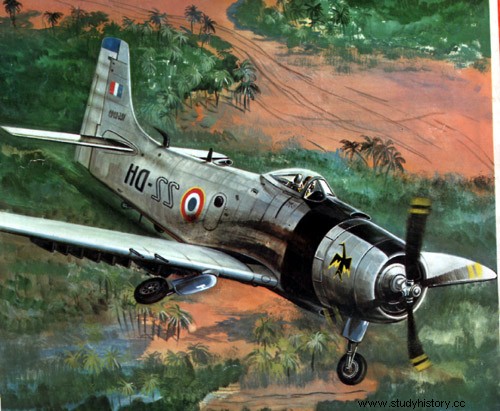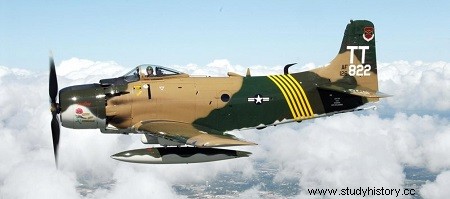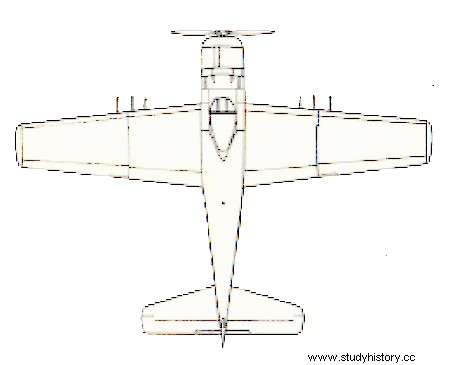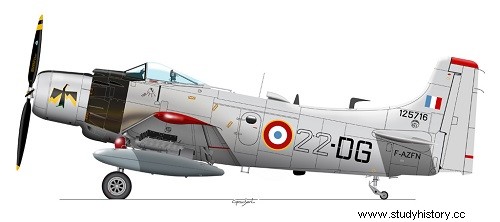
The Douglas A-1 Skyraider or AD Skyraider is a single-engine piston tactical support bomber, one of the last used by modern air forces. Indeed, it came out at the time when the first jet fighters fully entered the game. Nevertheless, he successfully demonstrated his abilities in combat
Design
The Skyraider was designed to replace the SBD Dauntless at the end of World War II, but it arrived too late to participate. The project was imagined in 1944 but it was not until 1945 that the device saw the light of day. Originally, it was to be called Dauntless II, but in February 1946, it took on the name Skyraider. The AD-1 designation comes from the fact that it was Douglas' first attack aircraft. The AD-2 was released in 1948 with modifications to the landing gear, in the cockpit and in the reinforcement of the wings. In 1950 appears the AD-3 with new modifications, in particular on the propellers and in the cockpit. Then comes the AD-4 version, it is the most built version. The AD-5 versions in 1951, with a larger interior space, allowed the transport of troops in its hold. Then came the AD-6, an improved version of the previous model, then the AD-7 which was built until 1958. 3,180 Skyraiders were built.
Variants

AD-5:Douglas' response to the Navy's request for an advanced submarine warfare aircraft resulted in the AD-5. Although based on the same device, the AD-5 is very different. First, the fuselage is widened to be able to seat two pilots side by side, and is lengthened by 60 cm. The fin is enlarged by 50%, but the wings remain unchanged. Behind the pilots take place a radar compartment and the two operators. The first flight of the AD-5 took place on August 17, 1951. The Navy seeing all the possibilities offered by the rear compartment, from troop transport to transporting wounded, immediately ordered 212 copies.
AD-5N:night attack version of the AD-5. It is four-seater:A pilot and a navigator seated one behind the other, two radar operators seated next to each other in the rear compartment.
AD-6:mix between AD4-B and AD-5. The reinforcements made on the AD-4 of the wings and the landing gear as well as the pylons for the bombs and the additional tanks, a jettisonable canopy, the hydraulic lifting of the landing gear and the improvements to the cockpit of the AD-5 are found on the AD-6. This version of the Skyraider also had a nuclear capability. Later, during the Vietnam War, the AD-6 was equipped with an electronic countermeasures pod against North Vietnamese SAMs and additional armor plates around the cockpit. No variant has been developed.
AD-7:the latest version of the Skyraider, it is equipped with the R3350-26WB and the landing gear is further reinforced. The installation of 20 mm cannons in the lift part of the wing having created premature fatigue of the wing, it was reinforced. The AD-7, like the AD-6, could deliver a nuclear weapon.
A-1D:new name for the AD-4NA in 1962. Version used by the Air Force in Algeria. It could carry a large amount of armament (3,600 kg).
A-1E:new name for the AD-5 in 1962. Multiplex version, originally a two-seater attack aircraft but quickly transformed for night attack. It can also be transformed into a 12-seater transport, a four-stretcher ambulance, a freighter carrying 907 kg of cargo, a photographic reconnaissance aircraft or even used for target location.
A-1G:new name for the AD-5N in 1962.
A-1H:new name for the AD-6 in 1962. Daytime single-seat bomber.
A-1J:new name for the AD-7 in 1962. Version equipped with a more powerful engine and a reinforced structure for low-altitude attacks. He was carrying a surprising variety of loads. In Vietnam, these external loads were up to 6,350 kg.
We can qualify the Skyraider as a real bomb truck, so impressive is the quantity and diversity of weapons to carry. Its main armament consisting of 4 20 mm guns and an offensive load of 3,630 kg up to 6,350 kg in Vietnam gave it a wide range of weapons.
Its fifteen attachment points made it possible to install:
38.5 gallon drop tanks.
3,000 ibs drop tanks.
SUU-11 7.62 mm minigun with 1,500 rounds.
napalm canisters.
packets with 25 CBU-25 cluster bombs.
AN-M47 phosphorus bombs.
2000 pound bombs.
250 pound bomb.
Mk-82 bomb.
2.75 inch rocket launcher tube.
LAU-59/68 rocket launcher pod for 7 rockets at phosphorus.
2.75 inch rocket pod.
CBU-22 smoke rockets.
Commitments
Originally designed to fly in World War II as a carrier-based fighter-bomber, it arrived too late to participate. Its role was to attack Japanese aircraft carriers. He saw service in the Korean War as a train chaser.
In 1956, the French Air Force, to replace its P-47s in the operations of the Algerian war, ordered 113. After transformations made by Sud Aviation, they began to enter service in February 1958, naval aviation also used it. Then they were assigned to Madagascar and Djibouti. A certain number were given to friendly countries:Cambodia, Gabon, Chad, R.C.A.
It was also used during the Vietnam War. They were among the first American planes to attack the coasts of North Vietnam following the Gulf of Tonkin Incidents in 1964, taking off from the aircraft carrier USS Ticonderoga stationed off Vietnam.
One of its missions was to escort the HH-3 Jolly Green Giant and their successors HH-53 Super Jolly Green Giant during the rescue of parachuted pilots in the middle of the jungle. Their affective nicknames being Sandy or Zorro. The A-1s were intended to draw enemy flak fire against them. Usually it was Sandy 01 and Sandy 02 who were in charge. Once located, the latter was targeted with rockets and 20 mm shells. Then Sandy 03 and Sandy 04 brought the helicopters to the position of the downed crew. During the recovery, the Skyraiders covered the helicopters. When necessary, especially when enemy fire was intense, the A-1s fired rockets which, when detonated, created a smoke screen to hide the helicopters. Once the crew had been recovered, the helicopters returned to base, followed by the Skyraiders. During the Vietnam War, Sandy units achieved an incredible 3833 rescues. Their motto is "So that others may live".
It was used massively to "clean" an area, locate and then annihilate the enemy with all available weapons. Its relative slowness made it easy prey for the Vietcong and North Vietnamese, but it was an asset in attacking ground targets with precision with its 20 mm guns and bombs. It was appreciated for its robustness and its ability to withstand heavy damage. Nevertheless, many A-1s were shot down by anti-aircraft guns and surface-to-air missiles. In fact, as the conflict progressed, it was confined to South Vietnam in attack missions because the anti-aircraft defenses of North Vietnam were too powerful (with the exception noteworthy in the rescue missions of American pilots who fell in hostile territory). It was used until the end of the Vietnam War by the United States and then by the South Vietnamese air force.
User countries
United States:- US Navy - USMC - USAF
South Vietnam
United Kingdom
Sweden
Gabon
Chad
France Purchase of skyraider by France to replace the P-47 Thunderbolt at the end of its potential
Italy
Role Ground Attack Aircraft / Tactical Support
Status Retired from active service
First flight March 18 1945
Commissioning 1946
Date of withdrawal 1972
Number built 3,180 (between 1945 and 1957)
Crew 1 pilot + 1 radio operator
Motorization
Engine Wright R-3350
Number 1
Type 18 radial cylinders on 2 air-cooled levels
Unit power 2,700 hp (1,986 kW)


Dimensions
Wingspan 15.24 m
Length r 11.83 m
Height 4.77 m
Wing area 37.16 m2
Weights
Empty 5,430 kg
With armament 8,180 kg
Maximum 11,340 kg

Performance
Maximum speed 550 km/h
Ceiling 8,660 m
Range of action 1,060 km
Wing load 220 kg/m2
Armament
Internal 4 x 20 mm guns
External 3,600 kg load (bombs, rockets, etc.)
